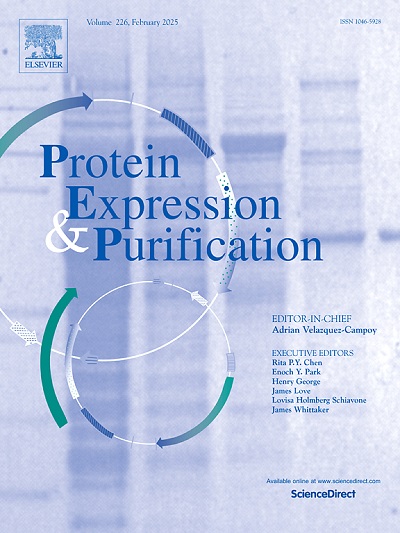Anti-biofilm and antibacterial effect of bacteriocin derived from Lactobacillus plantarum on the multidrug-resistant Acinetobacter baumannii
IF 1.4
4区 生物学
Q4 BIOCHEMICAL RESEARCH METHODS
引用次数: 0
Abstract
This research examines the impact of bacteriocin derived from Lactobacillus plantarum PTCC 1745 on the biofilm formations of A. baumannii isolates. Bacteriocin derived from L. plantarum PTCC 1745 was obtained through ammonium sulfate precipitation, cation-exchange chromatography, and reversed-phase high-performance liquid chromatography (RP-HPLC). Testing for bacteriocin susceptibility has been conducted using the broth dilution method. The anti-biofilm activity of bacteriocin was evaluated using a microtiter plate method. Quantitative real-time PCR assay evaluated bap gene expression in bacteriocin-treated cells. According to SDS-PAGE, bacteriocin from L. plantarum has a 25-kDa apparent molecular weight. The MICs of bacteriocin ranged from 30 to 120 μg/mL, while the MBCs varied between 60 and 120 μg/mL. Compared to the non-treated group, strains bacteriocin-treated isolates had 59 % less ability to form biofilm. The mean relative expression of the bap gene among the MDR A. baumannii isolates decreased by 52 % compared to the untreated control. This study demonstrated that bacteriocin derived from L. plantarum PTCC 1745 had antibacterial and antibiofilm activity against MDR A. baumannii isolates.
植物乳杆菌提取的细菌素对耐多药鲍曼不动杆菌的抗生物膜和抗菌作用
本研究探讨了植物乳杆菌(Lactobacillus plantarum PTCC 1745)提取的细菌素对鲍曼尼氏菌分离株生物膜形成的影响。通过硫酸铵沉淀、阳离子交换色谱法和反相高效液相色谱法(RP-HPLC)获得了植物乳杆菌 PTCC 1745 的细菌素。细菌素敏感性测试采用肉汤稀释法进行。细菌素的抗生物膜活性采用微孔板法进行评估。实时定量 PCR 检测评估了细菌素处理过的细胞中 bap 基因的表达。根据 SDS-PAGE 分析,植物桿菌细菌素的表观分子量为 25-kDa。细菌素的 MIC 在 30 至 120 μg/mL 之间,而 MBC 在 60 至 120 μg/mL 之间。与未处理组相比,经细菌素处理的菌株形成生物膜的能力降低了 59%。与未处理的对照组相比,MDR鲍曼不动杆菌分离株中bap基因的平均相对表达量减少了52%。本研究表明,植物酵母菌 PTCC 1745 衍生的细菌素对 MDR 鲍曼尼氏菌分离株具有抗菌和抗生物膜活性。
本文章由计算机程序翻译,如有差异,请以英文原文为准。
求助全文
约1分钟内获得全文
求助全文
来源期刊

Protein expression and purification
生物-生化研究方法
CiteScore
3.70
自引率
6.20%
发文量
120
审稿时长
32 days
期刊介绍:
Protein Expression and Purification is an international journal providing a forum for the dissemination of new information on protein expression, extraction, purification, characterization, and/or applications using conventional biochemical and/or modern molecular biological approaches and methods, which are of broad interest to the field. The journal does not typically publish repetitive examples of protein expression and purification involving standard, well-established, methods. However, exceptions might include studies on important and/or difficult to express and/or purify proteins and/or studies that include extensive protein characterization, which provide new, previously unpublished information.
 求助内容:
求助内容: 应助结果提醒方式:
应助结果提醒方式:


